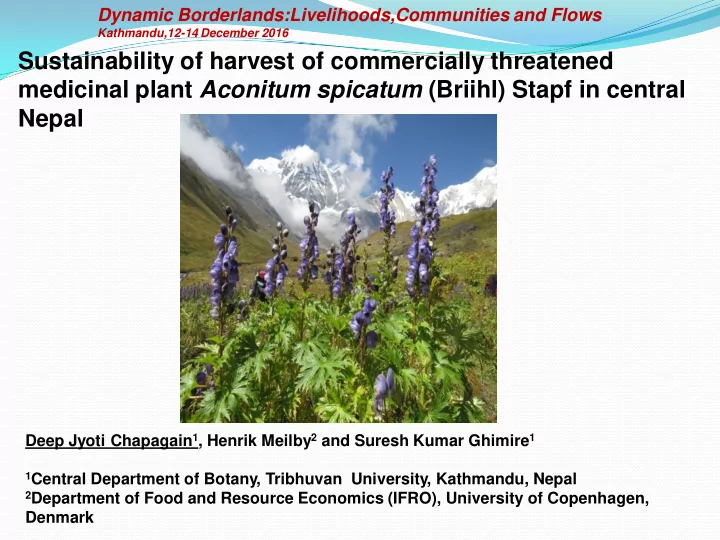

Dynamic Borderlands:Livelihoods,Communities and Flows Kathmandu,12-14 December 2016 Sustainability of harvest of commercially threatened medicinal plant Aconitum spicatum (Briihl) Stapf in central Nepal Deep Jyoti Chapagain 1 , Henrik Meilby 2 and Suresh Kumar Ghimire 1 1 Central Department of Botany, Tribhuvan University, Kathmandu, Nepal 2 Department of Food and Resource Economics (IFRO), University of Copenhagen, Denmark
Introduction Nepal harbors >2,000 species of non timber forest products (NTFPs) of which 90% are medicinal & aromatic plants (MAPs) Ophiocordyceps sinensis More than 100 species of MAPs are traded commercially MAPs have been identified as one of the 19 goods and services by Nepal Trade Integration Strategy, 2010 as having export potential Fritillaria cirrhosa Nepal is also a member of WTO since 2004 (source:ANSAB 2010) Aconitum spicatum
MAPs & Trade relationship Economic Prosperity • Foreign trade and exchange • Income and employment Medicinal and Aromatic plants • Livelihood improvement of people Trade 33 MAPs identified by the government of Nepal for commercial farming Source: IUCN
Major threats and challenges on sustainable uses of MAPs Illegal harvesting and trade Premature and overharvesting Inadequate awareness about the species biology and sustainability Over grazing and other human disturbances Lack of science-based management As a result, population of many species of MAPs declining, reproduction and growth rate reduced, and community composition and ecosystem is also changing
Study MAP species Aconite ( Aconitum spicatum ) Status : Vulnerable species Habit : Perennial herb Parts use : Tubers Habitat : Moist places at 3000-4300 m Regeneration : Tubers and seeds. Use : Highly poisonous, medicinal Local medicinal use – Cuts and wounds fever, headache, lung and intestine Trade trend of Aconite A. heterophyllum infections and cough 66.71 A. spicatum 70 Allopathic Use :Analgesic and antipyretic Traded Aconite in Ton 60 50 Prioritized by the government of Nepal 26.99 40 23.13 30 for economic development 11.38 20 10 Trade: In decreasing order and approx 0 100% of the harvested tuber is traded to 1998/99 2014/2015 India Year Source: Olsen 2005,TGGN 2016
Objectives Broader objective: To develop a sustainable harvesting model and management guidelines of Aconitum spicatum Specifically: To assess the effect of harvesting on biological characters of Aconitum spicatum along an elevation gradient in central Nepal
Study site Annapurna Conservation Area (ACA ) Source: ACAP 2014
Materials and method 2. Permanent plot 1. Reconnaissance establishment Survey 3 transects (2 x 18 m) in Local harvesters 3 populations (3200, consulted, study area 3600 and 3900 m); each identified and mapped divided into nine subplots (2 x 2 m) Population Dynamics 5. Population 3. Harvest simulation monitoring and each subplot randomly habitat assessment assigned into harvest Survival, recruitment. treatment of 0, 25, 50, Enrichment planting, 75 &100% biomass estimation 4. Stage classification and habitat and tagging assessment Sd, Jv, Adv and Adr are tagged
Sampling design (Aconitum Spicatum ): (belt transect)
Some snaps of field work
Result & Discussion Density in all stages was found highest between 3600 and 3800m. 1.2 Seedling Juvenile 1 Ad vegetative Flowering (Adr) 0.8 Density/square meter 0.6 0.4 0.2 0 3200 3400 3600 3800 4000 4200 Elevation in meter -0.2
Result contd.. Variation of Life history traits along the elevation gradient Plant height Average leaf area Total under ground dry weight 250 180 40 160 35 200 140 30 120 150 25 100 80 20 100 60 15 40 10 50 20 5 0 0 0 3200 3600 3900 3200 3600 3900 3200 3600 3900 Elevation(m) Elevation (m) Elevation (m) No. of Aborted Rep part Total Reproductive Part 14 50 45 12 40 10 35 8 30 25 6 20 4 15 10 2 5 0 0 3200 3600 3900 3200 3600 3900 Elevation (m) Elevation (m)
Result contd.. Effect of Harvest on seedling and adult density: Harvesting has negative impact on the seedling and flowering density. Seedling density Reproductive adult density 0 % change (2015-2016) 0 % change (2015-2016) -20 -20 -40 -40 -60 -60 -80 -80 -100 -100 0% 25% 50% 75% 0% 25% 50% 75% Harvesting level Harvesting level
Result contd.. Effect of harvest on total reproductive output: Harvest has negative impact on total reproductive output of the individual. 45 2015 40 Rep. parts per individual 2016 10 35 30 % change (2015-2016) 0 25 20 -10 15 10 -20 5 0 -30 0% 25% 50% 75% -40 0% 25% 50% 75% Harvesting level
Conclusions Pants growing in different altitude exhibit variations in a number of vegetative and reproductive characters Fitness of Aconitum spicatum decreases with increasing elevation Harvesting greatly effect reproductive output and density of adults and seedlings Recommendations A general awareness is needed to be created among the collectors and the local people about the population biology and conservation value of the species. Management should focus on increasing seedling recruitment and reducing damage to the reproductive adults so as to maintain long term viability of available resource base.
Acknowledgements Transiting to green growth Nepal-DANIDA project for the financial support Rufford Small grant (RSG) for financial support Department of National Parks & Wildlife Conservation Annapurna Conservation Area Project, National Trust for Nature Conservation Local people of the Annapurna Conservation Area
Thank you Thank You!!!
Recommend
More recommend